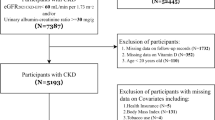Abstract
The renal handling of humanβ 2-microglobulin (β 2-m) was investigated in normal rat and in rat with cadmium-induced renal damage. Cadmium was administered either in drinking water at a concentration of 100 ppm for up to 16 months or by i. p. injection of 1 mg Cd/kg, five times a week for up to 4 months. When renal dysfunction has developed, namely after 2 and 10 months of the i. p. and oral treatment respectively, unlabelled humanβ 2-m was injected intravenously and its disappearance in serum and its urinary excretion were studied by means of a sensitive immunoassay. In serum, the level ofβ 2-m drops by about 90% during the 10 first min, then declines more slowly with a half life around 20 min. Serum disappearance curves ofβ 2-m in normal and cadmium-treated rats did not differ markedly.
The amount ofβ 2-m recovered in urine during the 4 h following the injection averaged 0.03% of the injected dose in normal rats. It increased on the average to 10% in rats treated i. p. with 1 mg Cd/kg for 3 months. However, in rats given 100 ppm Cd per os for 10 months, this amount averaged only 0.14%. A similar value was observed 5 months later, although at that stage, the critical level of cadmium in kidney cortex had been reached for 6–7 months. These data which were in accordance with the disturbances of the other renal parameters measured in cadmium-treated rats indicate that:
-
1)
humanβ 2-m is reabsorbed by rat kidney at a similar rate as by human kidney;
-
2)
if the occurrence of cadmium tubulopathy is concomitant with the saturation of cadmium-binding sites in kidney, its severity depends greatly on the rate at which cadmium reaches the saturated kidneys.
Similar content being viewed by others
References
Bernard A, Lauwerys R (1983) A simple continuous flow system for the automation of latex immunoassay by particle counting. Clin Chem (in press)
Bernard A, Goret A, Roels H, Buchet JP, Lauwerys R (1978) Experimental confirmation in rats of the mixed type proteinuria observed in workers exposed to cadmium. Toxicology 10:369–375
Bernard A, Lauwerys R, Starace V, Masson PL (1980a) Isolation of a new low molecular weightβ 2-globulin from urine of a worker with chronic cadmium poisoning. Biochem Biophys Res Commun 93:535–543
Bernard A, Goret A, Buchet JP, Roels H, Lauwerys R (1980b) Significance of cadmium levels in blood and urine during long-term exposure of rats to cadmium. J Toxicol Environ Health 6:175–184
Bernard A, Vyskocil A, Lauwerys R (1981a) Determination ofβ 2-microglobulin in human urine and serum by latex immunoassay. Clin Chem 27:832–837
Bernard A, Lauwerys R, Gengoux P (1981b) Characterization of the proteinuria induced by prolonged oral administration of cadmium in female rats. Toxicology 20:345–357
Bernier G, Conrad M (1969) Catabolism of humanβ 2-microglobulin by the rat kidney. Am J Physiol 217:1359–1362
Conway T, Poulik MD (1977) Catabolism of ratβ 2-microglobulin in the rat. J Lab Clin Med 89:1208–1214
Evrin PE, Wibell L (1972) The serum level and urinary excretion ofβ 2-microglobulin in apparently healthy subjects. Scand J Clin Lab Invest 29:69–74
Fredriksson A (1975) Renal handling ofβ 2-microglobulin in experimental renal disease. Scand J Clin Lab Invest 35:591–600
Fredriksson A, Peterson P (1975) Effects of renal dysfunction onβ 2-microglobulin metabolism. Scand J Urol Nephrol (Suppl) 26:61–76
Friberg L, Piscator M, Nordberg GF, Kjellström T (1974) Cadmium in the environment, 2nd ed. CRC Press, Cleveland, Ohio
Heinegård D, Tiderström G (1973) Determination of serum creatinine by a direct colorimetric method. Clin Chim Acta 43:305–310
Henry RJ (1965) Clinical Chemistry: Principles and Technics, 3rd ed. Harper and Row, New York
Lauwerys R, Buchet JP, Roels H, Bernard A, Stanescu D (1979) Investigation on the lung and kidney function in workers exposed to cadmium. Environ Health Perspect 28:137–145
Maack T, Johansson V, Kau ST, Figueirido D, Sigalem D (1979) Renal filtration, transport and metabolism of low molecular weight proteins: a review. Kidney Int 16:251–270
Piscator M (1962) Proteinuria in chronic cadmium poisoning. II. The applicability of quantitative and qualitative methods of protein determination for the demonstration of cadmium proteinuria. Arch Environ Health 5:325–332
Roels H, Lauwerys R, Buchet JP, Bernard A, Chettle D, Harvey T, Al-Haddad IK (1981) In vivo measurement of liver and kidney cadmium in workers exposed to this metal: its significance with respect to cadmium in blood and urine. Environ Res 26:217–240
Vincent C, Revillard JP, Charpentier B (1981) Mise en évidence de glycoprotéines fixant laβ 2-microglobuline humaine dans le serum de rat. CR Acad Sci Paris 292:755–758
Author information
Authors and Affiliations
Rights and permissions
About this article
Cite this article
Bernard, A., Viau, C. & Lauwerys, R. Renal handling of humanβ 2-microglobulin in normal and cadmium-poisoned rats. Arch Toxicol 53, 49–57 (1983). https://doi.org/10.1007/BF01460001
Received:
Issue Date:
DOI: https://doi.org/10.1007/BF01460001




